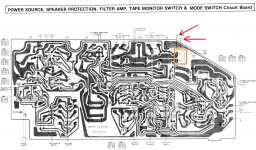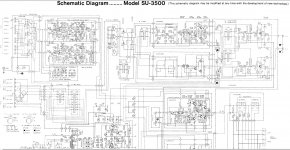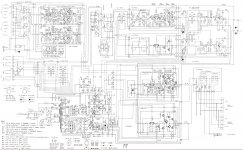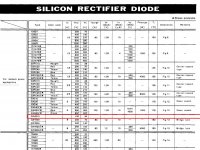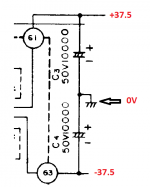I started the mod and replaced all caps but I made a big mistake.
I installed the two main 10000uf filter caps backwards .
I installed the 342 amp negative blue wire to the positive side the cap and the 341 amp red positive wire to the negative side of the second cap.
I blew the 2A fuse .and more damage was done
How can I fix this ? What should I expect ?
After I replaced the wires in normal position a channel was ok but now the protection relay has stopped working so both channels are dead.
In such situation how many components need replacement ?.
Maybe some transistors need replacement ? and fill work as new ?.
What transistors or components I need to replace ?
I have this amp for 10 years.
After working for 3 days to replace all caps I don't wanna give up . I already put to much effort so I can't believe is not working
I don't wanna give up . I already put to much effort so I can't believe is not working 
Help !
Thanks
I installed the two main 10000uf filter caps backwards .
I installed the 342 amp negative blue wire to the positive side the cap and the 341 amp red positive wire to the negative side of the second cap.
I blew the 2A fuse .and more damage was done
How can I fix this ? What should I expect ?
After I replaced the wires in normal position a channel was ok but now the protection relay has stopped working so both channels are dead.
In such situation how many components need replacement ?.
Maybe some transistors need replacement ? and fill work as new ?.
What transistors or components I need to replace ?
I have this amp for 10 years.
After working for 3 days to replace all caps
 I don't wanna give up . I already put to much effort so I can't believe is not working
I don't wanna give up . I already put to much effort so I can't believe is not working Help !
Thanks
Attachments
Last edited:
Yes, if you only had the two caps in the wrong way around, replace those with new ones, the correct way around and if it doesn't spring into life, after replacing the T2A fuse, replace the bridge rectifier.
If however the wrong polarity was put on the amplifier, that would be almost a bin job.
If however the wrong polarity was put on the amplifier, that would be almost a bin job.
Thanks.
Yesterday after I switched the cap polarity correctly and replaced the 2A fuse a channel was still ok but after a few minutes both channels went dead and the speakers relay stoped working.
I just hope that only the rectifier and the main caps need replacement.
If there is more damage to other components what comes next after rectifier ?.
I understand that the current goes from the main 10000uf caps to the rectifier and from rectifier goes to what components ??.
Maybe is better to also replace the components that comes after rectifier ??
If I take this amp to some local "tech engineer" he will "fix" the amp by also placing some old "out of specs "components that are extracted from TVs and old radios just in order to work for a few months so I don't trust those guys .
Yesterday after I switched the cap polarity correctly and replaced the 2A fuse a channel was still ok but after a few minutes both channels went dead and the speakers relay stoped working.
I just hope that only the rectifier and the main caps need replacement.
If there is more damage to other components what comes next after rectifier ?.
I understand that the current goes from the main 10000uf caps to the rectifier and from rectifier goes to what components ??.
Maybe is better to also replace the components that comes after rectifier ??
If I take this amp to some local "tech engineer" he will "fix" the amp by also placing some old "out of specs "components that are extracted from TVs and old radios just in order to work for a few months so I don't trust those guys .
Last edited:
I can't find the rectifier component S2HB10 in order to replace the damaged one.
But is it damaged? Replacing rectifiers is trivial, no need for same type if the replacement is physically compatible and able to withstand higher current and reverse voltage.
I installed the two main 10000uf filter caps backwards
YouTube
I understand that the current goes from the main 10000uf caps to the rectifier and from rectifier goes to what components
Nope.
The current in this circuit goes:
Mains - Transformer Primary:Secondary - Relay contacts - Rectifier - Caps - etc.
When you reverse the polarity of the capacitors, the internal insulator erodes and becomes conductive. This leads to a short circuit.
Your fuse blew because you provided the current a new path to the ground that had no load (the rest of the amplifier circuit) and this current flow (and consequent current demand on the primary) exceeded the value of the protection fuse.
The components that would have been potentially damaged are those in that short circuit loop as they were the ones exposed to the high current flow.
That is the caps (obviously), rectifier (but they are usually fairly robust), relay contacts (worth checking) and transformer. The transformer should have been protected by the fuse so I would personally focus on replacing the supply capacitors (don't turn the amp on with the suspect capacitors again, you may cause more damage. Reinstall the old original ones for testing if they are still good) and checking out that first power relay.
Good luck!
Last edited:
Last edited:
Thanks for info.
YouTube
Nope.
The current in this circuit goes:
Mains - Transformer Primary:Secondary - Relay contacts - Rectifier - Caps - etc.
When you reverse the polarity of the capacitors, the internal insulator erodes and becomes conductive. This leads to a short circuit.
Your fuse blew because you provided the current a new path to the ground that had no load (the rest of the amplifier circuit) and this current flow (and consequent current demand on the primary) exceeded the value of the protection fuse.
The components that would have been potentially damaged are those in that short circuit loop as they were the ones exposed to the high current flow.
That is the caps (obviously), rectifier (but they are usually fairly robust), relay contacts (worth checking) and transformer. The transformer should have been protected by the fuse so I would personally focus on replacing the supply capacitors (don't turn the amp on with the suspect capacitors again, you may cause more damage. Reinstall the old original ones for testing if they are still good) and checking out that first power relay.
Good luck!
If only the diode rectifier, main caps and relay can die in this scenario this would be very simple because there are only 3 suspects .
I just hope that this is the case .
I installed the caps backwards because the old caps are tricky .
On one side it writes negative black but under that writing is the positive and the negative is on the other side of the cap .
I don't understand why they did this in the past .
If a manufacturer writes negative on a cap the negative lead should be on the same side of the writing ...
I already ordered a new set of caps .
I don't know if is damaged or not because my meter was damaged so I can't measure right now.But is it damaged? Replacing rectifiers is trivial, no need for same type if the replacement is physically compatible and able to withstand higher current and reverse voltage.
I will start by replacing the caps .
If is not working I will replace relay and after that maybe the rectifier wil come next .
If I will replace all those and still not working I presume will need 2 or 3 more components replaced .
On one side it writes negative black but under that writing is the positive and the negative is on the other side of the cap .
I don't understand why they did this in the past .
If a manufacturer writes negative on a cap the negative lead should be on the same side of the writing ...
The amplifier circuit is powered by a 'split rail'. This means that you have a positive supply, a negative supply and a ground.
In your case, the circuit is supplied with +37.5v, 0v, -37.5v.
Look at the highlighted part of the circuit that I've attached.
The top capacitor has the "+" connected to +37.5v, the "-" connected to the 0v. All good there.
Now look at the bottom capacitor. That "+" is connected to the 0v. The same one we just connected the top capacitor's "-".
That is because the "-" is connected to a voltage that is more negative.
As to the bridge rectifier, yes that one should work as long as the physical dimensions are near enough. The '20' is rated to handle more power than the '10' that is in the amp but that's fine. Generally higher rating is better than lower as long as the other parameters remain the same.
Attachments
So I replaced the main caps today and the rectifier S2HB10 with KBPC802.
The relay is clicking but right after I press power on there is a shock to the speakers because the relay normally should connect after 5 seconds not immediately.
A channel is still dead and the other one sound very distorted .
When I press the power on that channel have a little clarity for 1 second and after that the signal becomes ultra distorted and thin .
This can be from relay ?. The new relay will come in a few days .
I think more components need replacement .
What should I replace next ?. I hope that rectifier a replaced is enough compatible .
The relay is clicking but right after I press power on there is a shock to the speakers because the relay normally should connect after 5 seconds not immediately.
A channel is still dead and the other one sound very distorted .
When I press the power on that channel have a little clarity for 1 second and after that the signal becomes ultra distorted and thin .
This can be from relay ?. The new relay will come in a few days .
I think more components need replacement .
What should I replace next ?. I hope that rectifier a replaced is enough compatible .
So I replaced the main caps today and the rectifier S2HB10 with KBPC802.
YouTube
Nope.
The current in this circuit goes:
Mains - Transformer Primary:Secondary - Relay contacts - Rectifier - Caps - etc.
When you reverse the polarity of the capacitors, the internal insulator erodes and becomes conductive. This leads to a short circuit.
Your fuse blew because you provided the current a new path to the ground that had no load (the rest of the amplifier circuit) and this current flow (and consequent current demand on the primary) exceeded the value of the protection fuse.
The components that would have been potentially damaged are those in that short circuit loop as they were the ones exposed to the high current flow.
That is the caps (obviously), rectifier (but they are usually fairly robust), relay contacts (worth checking) and transformer. The transformer should have been protected by the fuse so I would personally focus on replacing the supply capacitors (don't turn the amp on with the suspect capacitors again, you may cause more damage. Reinstall the old original ones for testing if they are still good) and checking out that first power relay.
Good luck!
The relay is clicking but right after I press power on there is a shock to the speakers because the relay normally should connect after 5 seconds not immediately.
A channel is still dead and the other one sound very distorted .
When I press the power on that channel have a little clarity for 1 second and after that the signal becomes ultra distorted and thin .
This can be from relay ?. The new relay will come in a few days .
I think more components need replacement . I hope that rectifier a replaced is enough compatible .
When I first placed the main caps backwards after that I placed the same caps in the normal position .
I presume that because it was just 1 second shock the caps did not get so deteriorated in order to create more damage ?.
What should I replace next ?.
I replaced the rectifier and the main caps and still one channel is dead and the other sounds just distorted .The caps should both be replaced even if they appear ok. A rectifier diode may have died as well. no other parts should need replacement as the voltage was not reversed. KBPC802 sounds like a bridge rectifier part, 200v should be ok.
Is not about rectifier .
By installing the caps with the wrong polarities some other parts have been damaged .
Maybe a diode and other caps ?
- Status
- Not open for further replies.
- Home
- Amplifiers
- Solid State
- I damaged my Technics SU-3500 amp
